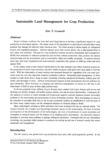Sustainable Land Management for Crop Production
JIRCAS international symposium series
| ISSN | 13406108 |
|---|---|
| 書誌レコードID(総合目録DB) | AA1100908X |

本文フルテキスト
intlsymp-9_39-48.pdf404.73 KB
Recent evidence confirms the view that land degradation is having a significant impact on crop production in developing regions. The major cause of the degradation is agricultural intensification using practices that damage the land and water resources base. The whole process is driven largely by widespread poverty and population pressure. Adverse impacts occur both on-and off-site, due to detrimental flows of soil, water, and nutrients. The goal for crop production systems should be sustainable land management (SLM), that maintains or enhances production and services, reduces production risks, protects the natural resources base and the environment, and is economically viable and socially acceptable. In practice farmers must cope with many biophysical and socio-economic constraints that operate on differing scales and work against SLM.
In the tropics, much of past research had focused on the high potential areas where intensive systems for the production of cereal crops dominate, and from which enormous yield gains have been made to feed the world. With the urbanization of many societies and increased demand for vegetables, fruit, and meat, peri-urban areas are now also important intensive production systems. Sustainable land management in these systems is under threat from a range of major constraints, including unbalanced fertilization, salinity; poor soil health, and shortages of water. Adverse environmental impacts include groundwater and soil pollution by agro-chemicals. More diversity in cropping and judicious management of inputs are the key to the achievement of SLM in many of these high potential areas.
In the low potential areas, millions of poor farmers must contend with major threats such as low and declining soil fertility, drought, soil acidity, erosion, salinity, and soil structural deterioration. Consequent offsite impacts of erosion on water systems and broad-scale negative nutrient balances present intractable problems to the communities and governments of many developing countries. More encouraging are some of the examples of successful SLM such as the oil palm production systems by smallholders in acid soil areas of the Asian warm, humid tropics, and the widespread adoption of minimum tillage in Brazil.
Many technological solutions to SLM constraints have been developed but few are adopted widely. The reasons include: the complex and knowledge-intensive nature of the technologies, the lack of farmer participation in the development of the technologies, the lack of involvement of social scientists and economists in research teams, and the absence of an enabling policy environment. An innovative research paradigm to overcome these problems is gaining widespread acceptance. Combined with the new information technology, the paradigm holds promise to accelerate the scaling up and use of research results that ensure sustainable land management.
In the tropics, much of past research had focused on the high potential areas where intensive systems for the production of cereal crops dominate, and from which enormous yield gains have been made to feed the world. With the urbanization of many societies and increased demand for vegetables, fruit, and meat, peri-urban areas are now also important intensive production systems. Sustainable land management in these systems is under threat from a range of major constraints, including unbalanced fertilization, salinity; poor soil health, and shortages of water. Adverse environmental impacts include groundwater and soil pollution by agro-chemicals. More diversity in cropping and judicious management of inputs are the key to the achievement of SLM in many of these high potential areas.
In the low potential areas, millions of poor farmers must contend with major threats such as low and declining soil fertility, drought, soil acidity, erosion, salinity, and soil structural deterioration. Consequent offsite impacts of erosion on water systems and broad-scale negative nutrient balances present intractable problems to the communities and governments of many developing countries. More encouraging are some of the examples of successful SLM such as the oil palm production systems by smallholders in acid soil areas of the Asian warm, humid tropics, and the widespread adoption of minimum tillage in Brazil.
Many technological solutions to SLM constraints have been developed but few are adopted widely. The reasons include: the complex and knowledge-intensive nature of the technologies, the lack of farmer participation in the development of the technologies, the lack of involvement of social scientists and economists in research teams, and the absence of an enabling policy environment. An innovative research paradigm to overcome these problems is gaining widespread acceptance. Combined with the new information technology, the paradigm holds promise to accelerate the scaling up and use of research results that ensure sustainable land management.
| 作成者 | Eric T. Craswell |
|---|---|
| 公開者 | Japan International Research Center for Agricultural Sciences |
| オンライン掲載日 | |
| 号 | 9 |
| 開始ページ | 39 |
| 終了ページ | 48 |
| 言語 | eng |
